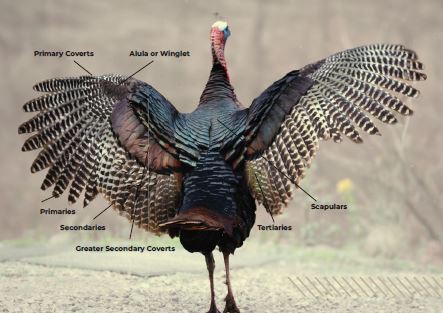Wild Science: Winging It
Like other birds, wild turkeys fly, but they don’t fly exactly like other birds. Turkey wings are different not only in color, but also in size, shape, feathering and how they flap compared to other birds. Let’s take a closer look at how wild turkeys wing it.
WINGSPAN
In general, bigger birds need bigger wings, but wings vary in size based on each species’ flight patterns. Comparing an adult tom to a bald eagle, a tom can weigh over 20 pounds yet has a relatively short wingspan for its size, only 4½ feet. A bald eagle, which weighs under 14 pounds, has a much greater wingspan of 7½ feet.
An eagle’s larger wings give it more “lift,” allowing it to fly farther with less effort. Bald eagles might soar over 200 miles in a day, but a wild turkey’s smaller wings allow it to fly agilely. Turkeys rarely fly more than a quarter mile at a time, and they need to maneuver around trees and other obstacles and to quickly escape from predators.
In addition, a bald eagle needs more wingspan in order to carry prey in its talons. Turkeys don’t carry anything aloft.
WING SHAPE
Next time you see a turkey vulture flying, notice the finger-like tips at the end of its long, broad wings. In the case of vultures, these feather-fingers allow them to circle efficiently in rising air currents. Wild turkey wings don’t have these finger-like tips because they don’t intend to stay in the air very long. Turkey wings are not only shorter, but more rounded compared to birds that circle and soar.

WING FEATHERS
Scientists call a bird’s wing feathers, “remiges.” All birds have three types of remiges: primaries, secondaries and tertiaries.
Primaries. Primaries are the largest wing feathers. Located from the middle to the tip of the wing, they propel the bird forward in the air. A bird can rotate and flex its primaries. Most birds, including wild turkeys, have eight to 10 primaries on each wing. If they injure or lose only a couple of them, their ability to fly is greatly impaired.
Secondaries. Secondaries are located mid-wing. They provide lift. They also overlap with each other creating the airfoil that gives a bird’s wing its aerodynamic qualities (thick in front, then tapering to thin on the trailing edge). A wild turkey has 18 to 19 secondary feathers per wing, about the same as a great blue heron. If a turkey or a heron lose a couple of its secondaries, it can still fly but awkwardly.
Tertiaries. Tertiaries are located closest to the “armpit” of a bird. On all birds, these feathers fill the space between the other wing feathers, giving the wing its shape. Birds can lose a few tertiaries without impacting their ability to fly.
FLAP RATE
The rate at which a bird flaps its wings varies by species as well. For example, bald eagles, which glide and circle, tend to flap their wings slowly and powerfully. Great blue herons also have a slow flap rate, to skim low over water. A wild turkey tends to flap in fast bursts, helping them launch into the air to escape a threat and to keep their bulk aloft on short flights.
